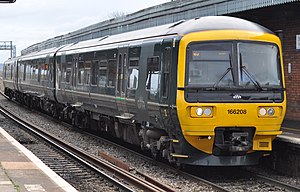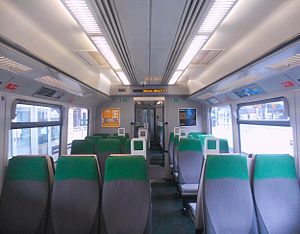British Rail Class 166
| British Rail Class 166 Networker Turbo Express |
|
|---|---|

Great Western Railway unit 166208 at Didcot Parkway
|
|

The refurbished interior of Standard Class
|
|
| In service | 1992 - Present |
| Manufacturer | ABB York |
| Family name | Networker |
| Constructed | 1992 - 1993 |
| Number built | 21 trainsets |
| Formation | 3 cars per trainset |
| Fleet numbers | 166201 - 166221 |
| Operator(s) | Great Western Railway |
| Specifications | |
| Car body construction | Welded aluminium |
| Maximum speed | 90 mph (145 km/h) |
| Prime mover(s) | One per car, Perkins 2006-TWH Diesel |
| Power output | 350 hp (261 kW) |
| Transmission |
Voith Hydraulic T211r 2 axles driven per car |
| Safety system(s) | AWS, TPWS |
| Coupling system | BSI |
| Track gauge | 1,435 mm (4 ft 8 1⁄2 in) standard gauge |
The British Rail Class 166 Turbo Express is a fleet of diesel multiple units (DMUs), originally specified by and built for British Rail, the then United Kingdom state owned railway operator. They were built by ABB at York Works between 1992 and 1993. The trains were designed as a faster, air conditioned variant of the Class 165 Turbo, intended for longer distance services, and, like the 165s, belong to the Networker family of trains. They were originally known as Networker Turbos to distinguish them from the electrically propelled members of that family.
The class is still in service, and is extensively operated by Great Western Railway on its services out of London Paddington station. The trains, along with that operator's Class 165 trains, are often known as Thames Turbos.
These units are a modification of the Class 165 design. They have a top speed of 90 mph (145 km/h) (suitable for mainline use), are carpeted throughout and have air-conditioning. Externally, the class 166 can be distinguished from a Class 165 by opening hoppers on every other window. Until late 2013 the presence of first class at each end was another distinguishing feature.
Other differences over a 165 are as follows:
Twenty-one 3-car units were built, numbered 166201-221. Each unit was formed of two outer driving motors, and an intermediate motor. The technical description of the formation is DMCO+MSO+DMSL. Individual carriages are numbered as follows:
The units were built to replace elderly Class 117, Class 119 and Class 121 DMUs, and locomotive-hauled trains on services from London Paddington along the Great Western Main Line.
...
Wikipedia
